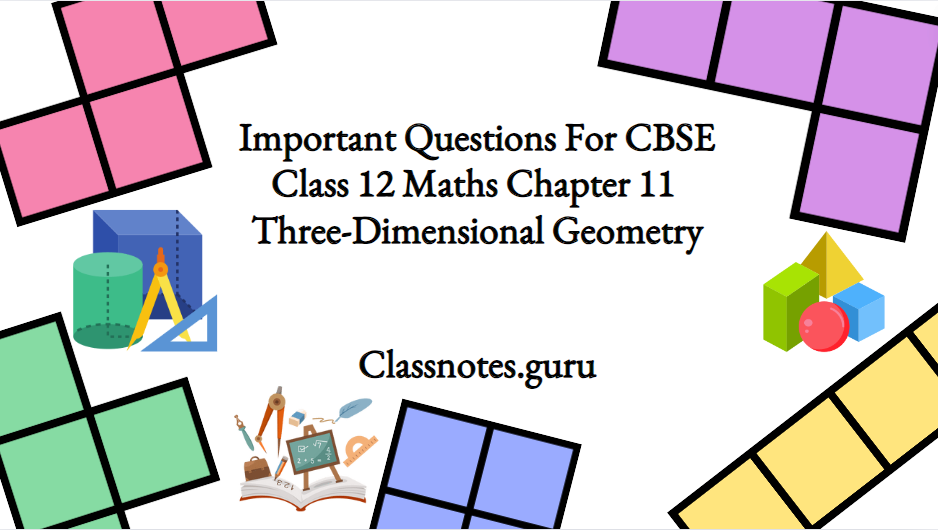CBSE Class 12 Maths Chapter 11 Three-Dimensional Geometry Important Questions
Question 1. The coordinates of the foot of the perpendicular drawn from the point (2, -3. 4) on the y-axis is?
- (2, 3, 4)
- (-2, -3, -4)
- (0,-3,0)
- (2,0,4)
Solution: 3. (0,-3,0)
The coordinates of the foot perpendicular on the y-axis from the points (2, -3, 4) are (0, -3, 0)
Read and Learn More CBSE Class 12 Maths Important Question and Answers
Question 2. Find the direction cosines of a line which makes equal angles with the coordinate axes.
Or,
A line passes through the point with position vector \(2 \hat{\mathbf{i}}-\hat{\mathbf{j}}+4 \hat{\mathrm{k}}\) and is in the direction of the vector \(\hat{\mathrm{i}}+\hat{\mathrm{j}}-2 \hat{\mathrm{k}}\). Find the equation of the line in Cartesian form.
Solution:
Let the line make angles α, β, and γ with OX, OY, and OZ axes with its dc’s l, m, and n respectively
Given, \(\alpha=\beta=\gamma\)
∴ \(\ell^2+m^2+n^2=1 \Rightarrow \cos ^2 \alpha+\cos ^2 \beta+\cos ^2 \gamma=1\)
⇒ \(3 \cos ^2 \alpha=1\)
(because \(\alpha=\beta=\gamma\))
or \(\cos ^2 \alpha=\frac{1}{3} \Rightarrow \cos \alpha= \pm \frac{1}{\sqrt{3}}\)
∴ Direction cosines are \(\frac{1}{\sqrt{3}}, \frac{1}{\sqrt{3}}, \frac{1}{\sqrt{3}}\) or \(\frac{-1}{\sqrt{3}}, \frac{-1}{\sqrt{3}}, \frac{-1}{\sqrt{3}}\)
Or,
Since the line passes through the point (2,-1,4) and its direction ratios are 1,1,-2;
⇒ Equation of a line in cartesian form is : \(\frac{x-2}{1}=\frac{y+1}{1}=\frac{z-4}{-2}\)
Three Dimensional Geometry Class 12 Important Questions
Question 3. Show that the lines \(\frac{1-x}{2}=\frac{y-3}{4}=\frac{z}{-1} \text { and } \frac{x-4}{3}=\frac{2 y-2}{-4}=z-1\) are coplanar.
Solution:
Given equation of lines are \(\frac{1-x}{2}=\frac{y-3}{4}=\frac{z}{-1}\) and \(\frac{x-4}{3}=\frac{2 y-2}{-4}=z-1\)
⇒ \(\frac{x-1}{-2}=\frac{y-3}{4}=\frac{z-0}{-1} \text { and } \frac{x-4}{3}=\frac{y-1}{-2}=\frac{z-1}{1}\)
In vector form, both the lines can be expressed as : \(\vec{r}=(\hat{i}+3 \hat{j})+\lambda(-2 \hat{i}+4 \hat{j}-\hat{k}) \text { and } \vec{r}=(4 \hat{i}+\hat{j}+\hat{k})+\mu(3 \hat{i}-2 \hat{j}+\hat{k})\)
On comparing it with \(\vec{\mathrm{r}}=\vec{\mathrm{a}}_1+\lambda \vec{\mathrm{b}}_1 \text { and } \vec{\mathrm{r}}=\vec{\mathrm{a}}_2+\mu \vec{\mathrm{b}}_2 \text {; }\)
⇒ \(\vec{a}_1=\hat{i}+3 \hat{j}, \vec{b}_1=-2 \hat{i}+4 \hat{j}-\hat{k}\),
⇒ \(\vec{a}_2=4 \hat{i}+\hat{j}+\hat{k} \text { and } \vec{b}_2=3 \hat{i}-2 \hat{j}+\hat{k}\)
The given lines are coplanar if \(\left(\vec{a}_2-\vec{a}_1\right) \cdot\left(\vec{b}_1 \times \vec{b}_2\right)=0\)
Now; \(\vec{a}_2-\vec{a}_1=(4 \hat{i}+\hat{j}+\hat{k})-(\hat{i}+3 \hat{j})=3 \hat{i}-2 \hat{j}+\hat{k}\)
and \(\vec{b}_1 \times \vec{b}_2\)
= \(\left|\begin{array}{ccc}\hat{i} & \hat{j} & \hat{k} \\ -2 & 4 & -1 \\ 3 & -2 & 1\end{array}\right|\)=\(\hat{i}(4-2)-\hat{j}(-2+3)+\hat{k}(4-12)=2 \hat{i}-\hat{j}-8 \hat{k}\)
Now, \(\left(\vec{a}_2-\vec{a}_1\right) \cdot\left(\vec{b}_1 \times \vec{b}_2\right)=(3 \hat{i}-2 \hat{j}+\hat{k}) \cdot(2 \hat{i}-\hat{j}-8 \hat{k})\)=6+2-8=0
Hence, both lines are coplanar.

Question 4. Find the shortest distance between the following lines: r = \(3 \hat{i}+5 \hat{j}+7 \hat{k}+\lambda(\hat{i}-2 \hat{j}+\hat{k}) \text { and } \vec{r}=(-\hat{i}-\hat{j}-\hat{k})+\mu(7 \hat{i}-6 \hat{j}+\hat{k})\).
Solution:
Given lines are: \(\vec{r}=3 \hat{i}+5 \hat{j}+7 \hat{k}+\lambda(\hat{i}-2 \hat{j}+\hat{k})\)
and \(\vec{r}=(-\hat{i}-\hat{j}-\hat{k})+\mu(7 \hat{i}-6 \hat{j}+\hat{k})\)
⇒ \(\vec{a}_1=3 \hat{i}+5 \hat{j}+7 \hat{k}, \vec{b}_1=\hat{i}-2 \hat{j}+\hat{k}\)
⇒ \(\vec{a}_2=-\hat{i}-\hat{j}-\hat{k}, \vec{b}_2=7 \hat{i}-6 \hat{j}+\hat{k}\)
Now; \(\vec{a}_2-\vec{a}_1=-4 \hat{i}-6 \hat{j}-8 \hat{k}, \vec{b}_1 \times \vec{b}_2\)
= \(\left|\begin{array}{ccc}
\hat{i} & \hat{j} & \hat{k} \\
1 & -2 & 1 \\
7 & -6 & 1
\end{array}\right|=4 \hat{i}+6 \hat{j}+8 \hat{k}\)
∴ distance between lines is given by d = \(\left|\frac{\left(\vec{a}_2-\vec{a}_1\right) \cdot\left(\vec{b}_1 \times \vec{b}_2\right)}{\left|\vec{b}_1 \times \vec{b}_2\right|}\right|\)
⇒ d = \(\left|\frac{(-4 \hat{i}-6 \hat{j}-8 \hat{k}) \cdot(4 \hat{i}+6 \hat{j}+8 \hat{k})}{|4 \hat{i}+6 \hat{j}+8 \hat{k}|}\right|=\left|\frac{-16-36-64}{\sqrt{16+36+64}}\right|\)
or d = \(\frac{116}{\sqrt{116}}=\sqrt{116}\) units
Question 5. Find the shortest distance between the lines: \(\vec{i}=2 \hat{i}-\hat{j}+\hat{k}+\lambda(3 \hat{i}-2 \hat{j}+5 \hat{k}) \text { and } \vec{r}=3 \hat{i}+2 \hat{j}-4 \hat{k}+\mu(4 \hat{i}-\hat{j}+3 \hat{k})\)
Solution:
Given lines are: \(\vec{i}=2 \hat{i}-\hat{j}+\hat{k}+\lambda(3 \hat{i}-2 \hat{j}+5 \hat{k}) \text { and } \vec{r}=3 \hat{i}+2 \hat{j}-4 \hat{k}+\mu(4 \hat{i}-\hat{j}+3 \hat{k})\)
Here; \(\vec{a}_1=2 \hat{i}-\hat{j}+\hat{k}, \vec{b}_1=3 \hat{i}-2 \hat{j}+5 \hat{k}, \vec{a}_2=3 \hat{i}+2 \hat{j}-4 \hat{k}, \vec{b}_2=4 \hat{i}-\hat{j}+3 \hat{k}\)
⇒ \(\left(\vec{a}_2-\vec{a}_1\right)=\hat{i}+3 \hat{j}-5 \hat{k} \text { and } \vec{b}_1 \times \vec{b}_2=\left|\begin{array}{ccc}
\hat{i} & \hat{j} & \hat{k} \\
3 & -2 & 5 \\
4 & -1 & 3
\end{array}\right|\)
⇒ \(\vec{b}_1 \times \vec{b}_2=-\hat{i}+11 \hat{j}+5 \hat{k}\)
∴ \(\left|\vec{b}_1 \times \vec{b}_2\right|=\sqrt{1+121+25}=\sqrt{147}\)
⇒ The shortest distance b/w given lines is:
S.D. = \(\left|\frac{\left(\vec{a}_2-\vec{a}_1\right) \cdot\left(\vec{b}_1 \times \vec{b}_2\right)}{\left|\vec{b}_1 \times \vec{b}_2\right|}\right|\)
= \(\left|\frac{(\hat{i}+3 \hat{j}-5 \hat{k}) \cdot(-\hat{i}+11 \hat{j}+5 \hat{k})}{\sqrt{147}}\right|\)
= \(\left|\frac{-1+33-25}{\sqrt{147}}\right|=\frac{7}{\sqrt{147}}\) units
Class 12 Maths Chapter 11 Important Questions With Solutions
Question 6. Find the shortest distance between the lines \(\vec{\mathrm{r}}=(4 \hat{\mathrm{i}}-\hat{\mathrm{j}})+\lambda(\hat{\mathrm{i}}+2 \hat{\mathrm{j}}-3 \hat{\mathrm{k}})\) and \(\vec{r}=(\hat{i}-\hat{j}+2 \hat{k})+\mu(2 \hat{i}+4 \hat{j}-5 \hat{k})\).
Solution:
Equation of lines are Equation of lines are \(\vec{r}=(4 \hat{i}-\hat{j})+\lambda(\hat{i}+2 \hat{j}-3 \hat{k})\) and \(\vec{r}=(\hat{i}-\hat{j}+2 \hat{k})+\mu(2 \hat{i}+4 \hat{j}-5 \hat{k})\)
where \(\vec{a}_1=4 \hat{i}-\hat{j}, \vec{b}_1=\hat{i}+2 \hat{j}-3 \hat{k}\), \(\vec{a}_2=\hat{i}-\hat{j}+2 \hat{k}, \vec{b}_2=2 \hat{i}+4 \hat{j}-5 \hat{k}\)
⇒ \(\vec{a}_2-\vec{a}_1=-3 \hat{i}+2 \hat{k} \text { and } \vec{b}_1 \times \vec{b}_2\)
= \(\left|\begin{array}{ccc}
\hat{i} & \hat{j} & \hat{k} \\
1 & 2 & -3 \\
2 & 4 & -5
\end{array}\right|\)
∴ \(\vec{b}_1 \times \vec{b}_2=2 \hat{i}-\hat{j} \Rightarrow\left|\vec{b}_1 \times \vec{b}_2\right|=\sqrt{5}\)
⇒ Required S.D. = \(\left|\frac{\left(\vec{a}_2-\vec{a}_1\right) \cdot\left(\vec{b}_1 \times \vec{b}_2\right)}{\left|\vec{b}_1 \times \vec{b}_2\right|}\right|=\left|\frac{(-3 \hat{i}+2 k) \cdot(2 \hat{i}-\hat{j})}{\sqrt{5}}\right|=\left|\frac{-6}{\sqrt{5}}\right|=\frac{6}{\sqrt{5}}\) units
Three Dimensional Geometry Subjective And Objective Questions
Question 7. Find the shortest distance between the following lines: \(\frac{x+1}{7}=\frac{y+1}{-6}=\frac{z+1}{1}\) and \(\frac{x-3}{1}=\frac{y-5}{-2}=\frac{z-7}{1}\)
Solution:
The given lines are \(\frac{x+1}{7}=\frac{y+1}{-6}=\frac{z+1}{1}\)….(1)
and \(\frac{x-3}{1}=\frac{y-5}{-2}=\frac{z-7}{1}\)….(2)
Line (1) passes through points (-1, -1, -1) with its Dr’s 7, -6, 1, and line (2) passes through points (3, 5, 7) with its Dr’s 1,-2, 1
So, vector equation of lines (1) and (2) are: \(\vec{r}_1=-\hat{i}-\hat{j}-\hat{k}+\lambda \cdot(7 \hat{i}-6 \hat{j}+\hat{k}) \text { and } \vec{r}_2=3 \hat{i}+5 \hat{j}+7 \hat{k}+\mu(\hat{i}-2 \hat{j}+\hat{k})\)
which are of the form: \(\vec{r}_1=\vec{a}_1+\lambda \vec{b}_1 \text { and } \vec{r}_2=\vec{a}_2+\mu \vec{b}_2\)
Here; \(\vec{a}_1=-\hat{i}-\hat{j}-\hat{k}, \vec{b}_1=7 \hat{i}-6 \hat{j}+\hat{k} \text {, }\)
⇒ \(\vec{\mathrm{a}}_2=3 \hat{\mathrm{i}}+5 \hat{\mathrm{j}}+7 \hat{\mathrm{k}}, \quad \vec{\mathrm{b}}_2=\hat{\mathrm{i}}-2 \hat{\mathrm{j}}+\hat{\mathrm{k}}\)
⇒ \(\vec{\mathrm{a}}_2-\vec{\mathrm{a}}_1=4 \hat{\mathrm{i}}+6 \hat{\mathrm{j}}+8 \hat{\mathrm{k}}\)
and \(\vec{b}_1 \times \vec{b}_2=\left|\begin{array}{ccc}\hat{i} & \hat{j} & \hat{k} \\ 7 & -6 & 1 \\ 1 & -2 & 1\end{array}\right|=-4 \hat{i}-6 \hat{j}-8 \hat{k}\)
⇒ \(\left|\vec{\mathrm{b}}_1 \times \vec{\mathrm{b}}_2\right|=\sqrt{(-4)^2+(-6)^2+(-8)^2}=2 \sqrt{29}\)
∴ The shortest distance between given lines is:
S.D. = \(\left|\frac{\left(\vec{b}_1 \times \vec{b}_2\right) \cdot\left(\vec{a}_2-\vec{a}_1\right)}{\left|\vec{b}_1 \times \vec{b}_2\right|}\right|=\left|\frac{(-4 \hat{i}-6 \hat{j}-8 \hat{k}) \cdot(4 \hat{i}+6 \hat{j}+8 \hat{k})}{2 \sqrt{29}}\right|\)
= \(\frac{116}{2 \sqrt{29}}=\frac{58}{\sqrt{29}}=2 \sqrt{29}\) units
